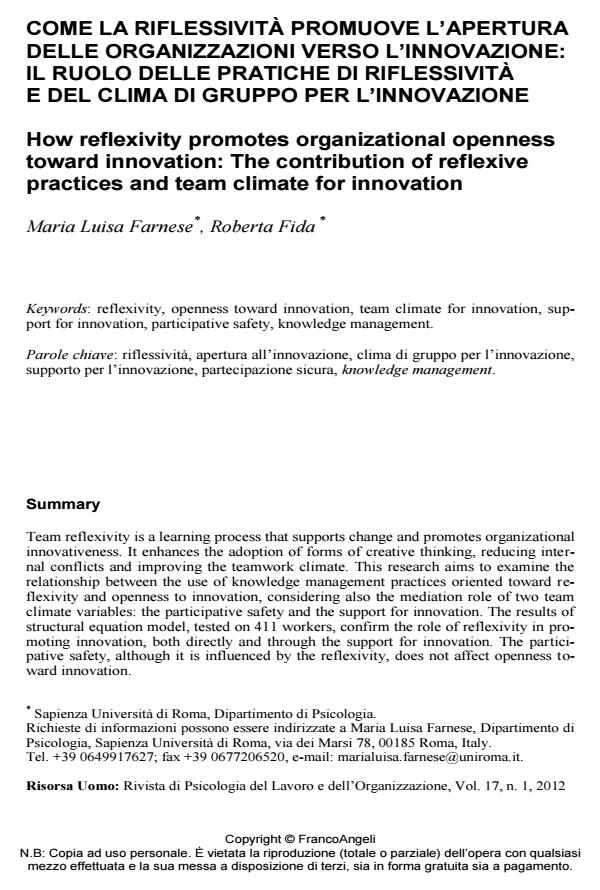Come la riflessività promuove l’apertura delle organizzazioni verso l’innovazione: il ruolo delle pratiche di riflessività e del clima di gruppo per l’innovazione
Titolo Rivista RISORSA UOMO
Autori/Curatori Maria Luisa Farnese, Roberta Fida
Anno di pubblicazione 2014 Fascicolo 2012/1
Lingua Italiano Numero pagine 16 P. 87-102 Dimensione file 897 KB
DOI 10.3280/RU2012-001009
Il DOI è il codice a barre della proprietà intellettuale: per saperne di più
clicca qui
Qui sotto puoi vedere in anteprima la prima pagina di questo articolo.
Se questo articolo ti interessa, lo puoi acquistare (e scaricare in formato pdf) seguendo le facili indicazioni per acquistare il download credit. Acquista Download Credits per scaricare questo Articolo in formato PDF

FrancoAngeli è membro della Publishers International Linking Association, Inc (PILA)associazione indipendente e non profit per facilitare (attraverso i servizi tecnologici implementati da CrossRef.org) l’accesso degli studiosi ai contenuti digitali nelle pubblicazioni professionali e scientifiche
Team reflexivity is a learning process that supports change and promotes organizational innovativeness. It enhances the adoption of forms of creative thinking, reducing internal conflicts and improving the teamwork climate. This research aims to examine the relationship between the use of knowledge management practices oriented toward reflexivity and openness to innovation, considering also the mediation role of two team climate variables: the participative safety and the support for innovation. The results of structural equation model, tested on 411 workers, confirm the role of reflexivity in promoting innovation, both directly and through the support for innovation. The participative safety, although it is influenced by the reflexivity, does not affect openness toward innovation.
Parole chiave:Riflessività, apertura all’innovazione, clima di gruppo per l’innovazione, supporto per l’innovazione, partecipazione sicura, knowledge management.
- Methods to Measure the Extent to which Teachers’ Points of View Influence Creativity and Factors of Creative Personality: A Study with Italian Pupils Maria Elvira De Caroli, Orazio Licciardello, Elisabetta Sagone, Claudia Castiglione, in Key Engineering Materials /2010 pp.535
DOI: 10.4028/www.scientific.net/KEM.437.535
Maria Luisa Farnese, Roberta Fida, Come la riflessività promuove l’apertura delle organizzazioni verso l’innovazione: il ruolo delle pratiche di riflessività e del clima di gruppo per l’innovazione in "RISORSA UOMO " 1/2012, pp 87-102, DOI: 10.3280/RU2012-001009